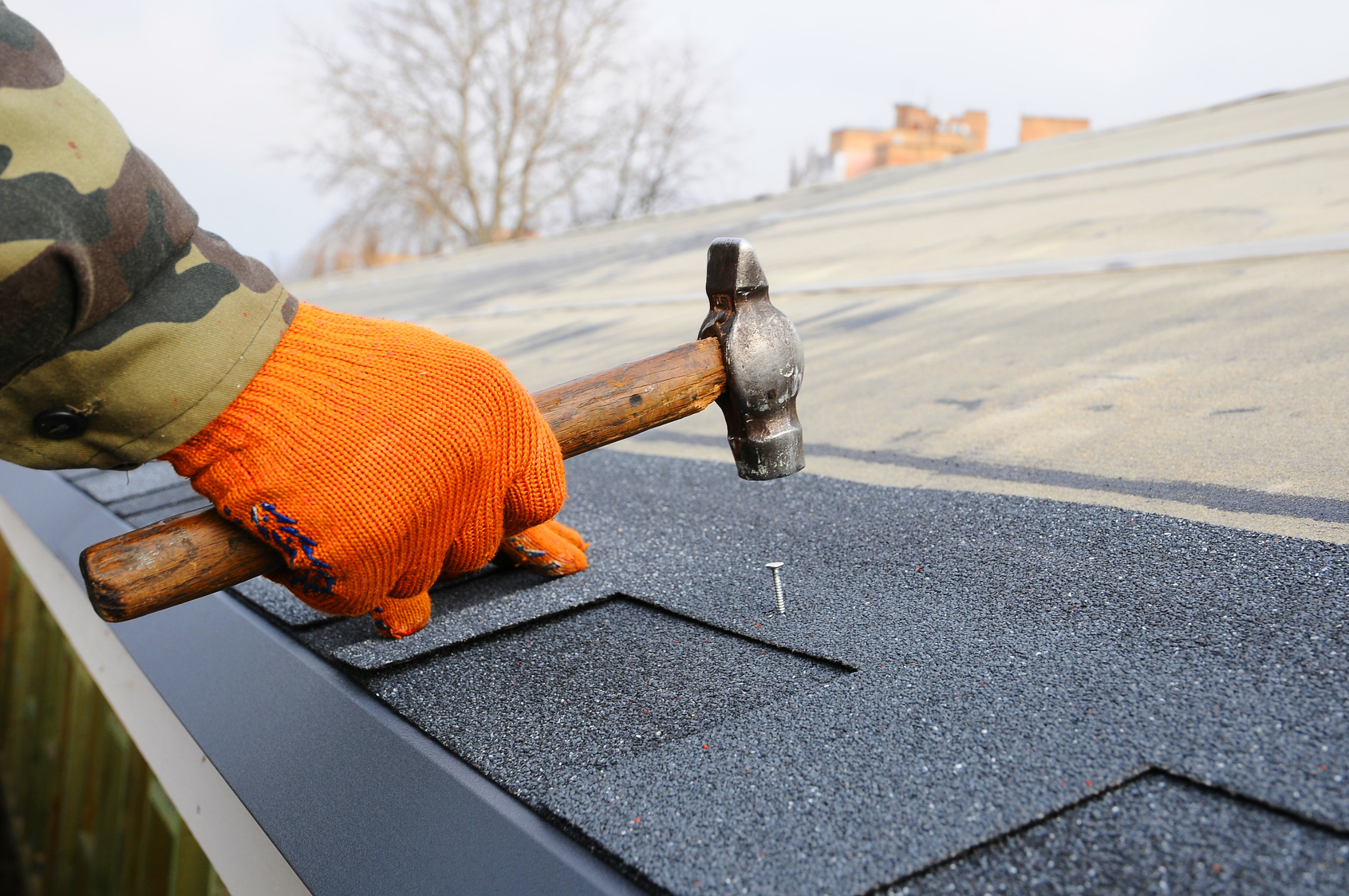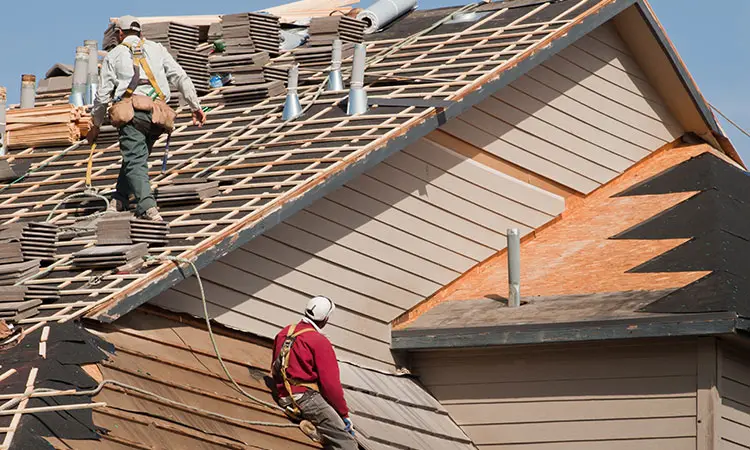DIY Roof Repair Work: A Step-by-Step Guide to Repairing Common Issues
You can deal with typical roof covering concerns yourself by starting with a thorough evaluation for noticeable damage like missing out on roof shingles or sagging locations. Spot leaks by securing replacing and blinking damaged shingles. Routine checks aid avoid expensive repair services.
 roof repair
roof repairAnalyzing Your Roof for Damages
Before you climb onto your roof, it's necessary to inspect it from the ground to determine any type of noticeable signs of damages. Look for missing roof shingles, curled sides, or discoloration that may suggest leakages.
Next, examine your rain gutters for granules from shingles or standing water, both of which can aim to roof troubles. These can be signs of water damages connected to your roofing system. if you identify any type of stains on ceilings or walls inside your home.
Do not neglect to check out flashing around smokeshafts and vents, as harmed blinking can lead to leaks. It's best to address it quickly to prevent a lot more considerable repair work later on if you observe anything concerning. Always focus on security, and do not hesitate to call a professional if required.
Collecting the Essential Tools and Products
Before you begin your roof covering repair service, you need to collect the right tools and materials. Knowing what crucial devices you'll require, developing a checklist of required products, and prioritizing security gear will certainly establish you up for success. Allow's look at what you'll require to tackle this project effectively and securely.
 roof repair
roof repairEssential Devices Introduction
A strong roofing system repair work starts with the right devices and materials at your side. Grab a durable ladder to securely access your roof covering.
Safety equipment is vital too; a pair of work gloves and security goggles will certainly shield you from sharp edges and debris. A measuring tape guarantees exact measurements while a pry bar helps get rid of damaged shingles. With these tools in hand, you'll prepare to deal with different roof covering repair services confidently.
Required Materials List
With your tools all set, it's time to collect the products required for your roofing system repair. Initially, check your tiles. Buy matching substitute shingles if they're damaged. You'll also need roof nails, a solid adhesive, and a sealant to assure everything stays water tight. Do not forget a tarp or roofing paper to safeguard subjected areas while you function. Consider buying a waterproof membrane layer as well if you're dealing with leaks. For blinking repair services, acquire brand-new blinking materials that fit your roof covering type. Order a container or container for any particles you'll get rid of. Having all these products accessible will make your repair work process smoother and extra reliable, so you can do the job right.
Safety Equipment Relevance
While you could be enthusiastic to start your roofing fixing, don't overlook the relevance of safety gear. Using the right devices can stop major injuries and guarantee you work successfully. Start with a durable safety helmet to safeguard your head from dropping particles. Non-slip footwear are important for keeping grasp on the roofing's surface area. Don't neglect gloves; they'll keep your hands risk-free from sharp devices and materials. Safety safety glasses will certainly protect your eyes from dirt and debris. A harness is a has to if your roof is high or high, preventing drops. A first-aid kit ought to always be on hand for minor injuries. Prioritizing security gear establishes you up for a successful and safe and secure fixing work.
Covering Roof Leakages
When you discover a leakage, the very first action is recognizing its resource to guarantee a reliable spot. You'll need to choose the right materials for a long lasting repair as soon as you identify the issue. We'll walk you with the most effective application strategies to secure those leakages and protect your home.
Determining Leakage Sources
Just how do you pinpoint the resource of a roof get more leak? Beginning by examining your roof covering for visible damage or wear. If it's secure, climb up to your roofing system and visually check for any irregularities.
Choosing Spot Materials
Selecting the right patch products is essential for effectively repairing a roofing leak. For flat roofing systems, utilize a specialized patching product developed for that surface.
Constantly make certain the products are suitable with your existing roofing system to assure a long-lasting repair. Likewise, inspect the climate condition; some materials require cozy or completely dry temperatures to adhere properly. Select high-grade products to stay clear of constant repairs down the line. By choosing the right products, you'll establish yourself up for a successful patching work.
Application Techniques Explained
Applying patch products effectively is important for securing roofing system leakages and preventing additional damage. Beginning by cleaning the area around the leakage, getting rid of any type of debris, dust, or loosened shingles. This ensures a solid bond between the roofing and the spot surface area. Next, cut your patch product to fit over the harmed area, extending it at the very least two inches past the edges of the leakage. Apply a generous layer of roofing adhesive or sealant to the area, after that push the spot strongly right into place. Ravel any air bubbles and validate the edges are well sealed. Finally, use an added layer of sealant over the patch edges for added security. Permit the patch to heal totally prior to revealing it to rainfall or severe weather condition.
Replacing Damaged Tiles
When you notice harmed tiles on your roofing, it's vital to resolve the issue promptly to avoid further leaks and structural damages. Beginning by collecting your tools: a crowbar, hammer, roof covering nails, and substitute roof shingles that match your existing ones. Very carefully lift the damaged roof shingles with your pry bar to eliminate it without disturbing the bordering tiles. Check the location below for any kind of indications of damage once it's cost-free. If whatever looks great, slide the new tile right into area, straightening it with the others. Safeguard it with nails, making sure to adhere to the supplier's standards for positioning. Bear in mind to cover the nail heads with a little bit of roof concrete to ensure correct sealing. Step back and examine your job to confirm a seamless look. With these fast steps, you can successfully replace damaged tiles and maintain your roof covering's honesty.
Cleaning and Keeping Gutters
To maintain your roof in top problem, consistently cleansing and preserving your gutters is crucial. Clogged up rain gutters can cause water damages, mold and mildew growth, and even structural issues. Beginning by examining your rain gutters for debris like fallen leaves, twigs, and dirt. Use a durable ladder and wear handwear covers to get rid of any build-up. An inside story or trowel can assist you clear persistent clogs.
Next, flush your gutters with a garden tube to ensure water streams easily. Look for leaks or rust areas while you're at it. Think about applying a sealer or changing affected areas. if you discover any kind of issues.
To avoid future obstructions, set up rain gutter guards or displays, and make it a routine to cleanse your gutters at the very least two times a year, particularly before hefty rainfall or snow. Regular upkeep not just extends the life of your seamless gutters but also safeguards your whole roof covering system.
Sealing Roofing Vents and Flashing
Securing roofing vents and blinking is crucial for stopping leaks and safeguarding your home from water damage. Begin by evaluating the locations around your roof vents and flashing for any gaps or fractures.
Apply the sealer generously, loading all voids and splits, then smooth it out with your finger or a caulking device for a neat surface. Ensure the sealant extends a little beyond the edges to create a solid bond.
Enable the sealer to treat as per the maker's instructions, usually a few hours or overnight. After securing, it's a great idea to examine your job after a rainstorm to validate everything remains water tight. Regular maintenance of your roof covering vents and blinking can save you from costly fixings down the line.
Inspecting and Repairing Roofing system Valleys
Roof valleys are crucial areas where two inclines fulfill, and they play a vital role in guiding water away from your home. To examine your roof valleys, begin by climbing up securely and looking for indications of damages like loosened tiles, cracks, or debris.
For small repairs, replace harmed tiles and use roof cement to secure gaps. If the valley is thoroughly damaged, you could need to remove the afflicted section and install brand-new blinking. Make sure to overlap the new materials correctly to assure a limited seal. After finishing your repair work, keep track of the valleys during hefty rain to verify they're working correctly. Dealing with roof valleys promptly will assist protect your home from water damages and expand the life of your roof.
Regularly Asked Inquiries
If My Roofing Needs Replacement Instead of Repair?, how Can I Establish.
To identify if your roof needs substitute, check for substantial damages, sagging locations, or missing out on tiles. Take into consideration substitute over repair service. if leaks continue in spite of repair services or it's nearing the end of its life expectancy.
What Safety and security Precautions Should I Take While Repairing My Roof Covering?
When fixing your roof, constantly wear a harness and non-slip footwear. Make certain your ladder's steady, avoid functioning in negative weather condition, and have a person nearby to assist you in situation of emergencies.
Exactly how Commonly Should I Inspect My Roof Covering for Damage?
You should examine your roof at the very least twice a year, preferably in spring and loss. After severe climate, check for damage too. Normal examinations can assist you catch issues prior to they develop into pricey repairs.
Can I Fix My Roof Covering in Bad Weather Conditions?
You should not attempt roofing fixings in negative weather. Rainfall, snow, or solid winds can enhance dangers and complicate the process. Wait on clear conditions to guarantee your safety and accomplish an appropriate repair work.
What Should I Do if I Run into Wild Animals in My Attic During Fixes?
If you experience wildlife in your attic room during repair work, stop immediately. Protect the area, stay clear of stunning the animals, and speak to a professional wild animals removal service to securely take care of the scenario prior to proceeding your job.
Before you begin your roof covering fixing, you require to collect the right devices and products.A strong roofing repair begins with the right tools and products at your side.With your tools ready, it's time to collect the products needed for your roof repair.Picking the appropriate spot products is essential for successfully fixing a roofing leak. Taking care of roofing valleys quickly will help safeguard your home from water damages and extend the life of your roofing system.